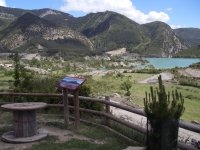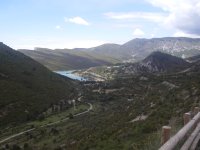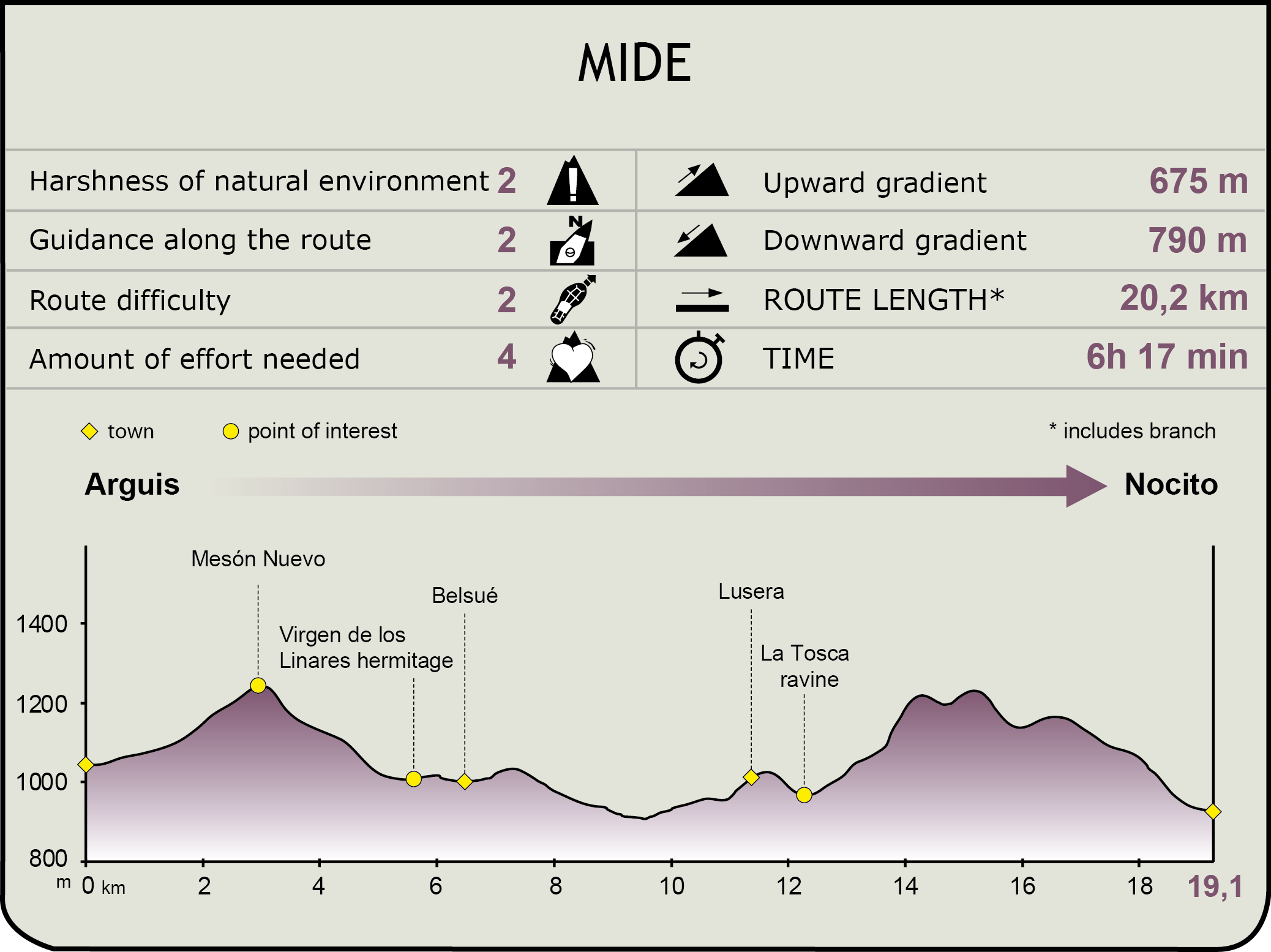Net of Natural
Trails

Stage 5: Arguis – Nocito
Description
Uninhabited villages and the influence of the Pyrenees
The fifth Stage of the Nature Trail of La Hoya de Huesca goes through the villages of Arguis and Nocito covering, along its 20.2 km, the valleys of Belsué and Nocito, which are hidden on the northern side of the Sierras of Gabardiella and Guara, respectively. They cross the municipalities of Arguis and Nueno, which are home to several rural villages, some of which are deserted at the present time, and where you can notice the influence of the Pyrenees both in their landscape and in their popular agriculture. A large part of the path coincides with the route of the GR-1 and in the final Stage with the GR-16.
From Arguis to Belsué

The main route of this Stage leaves from the Nature Trail’s informative panel located next to the public washhouse of Arguis and goes along one of the village’s traditional streets in the direction of the church of San Miguel. After leaving on your right a turn-off to the chapel of Soldevilla and going around the church, you continue as far as the road, where you walk some 50 m to the right.
After taking a signposted turn-off on the left to the chapel of La Magdalena and El Mesón Nuevo, the trail continues between the houses to cross a small stream. Once it has passed over it, the trail ascends through a marl area until it reaches a bench, which, like a viewpoint, looks over the reservoir of Arguis, the oldest operating reservoir in Aragón. The continuous upward and downward sections across these greyish hills follow on after each other, making headway between long irrigation ditches and channels excavated in the lead-coloured sedimentary rocks on which gorse (Genista scorpius), thyme(Thymus sp.), boxes(Buxus sempervirens) and Pyrenean hedgehog (Echinospartum horridum) survive.

Crossing the southern face of the Sierra of Bonés, the Nature Trail reaches a small riverbed where there is an old shepherd’s hut in ruins. Some metres further on, you will coincide with the route of the gas pipelines, which is marked with typical yellow signs. Following a slow but continuous climb and after passing by a large rock next to the path, you will reach a high-voltage tower. The path then turns into a track and leads to a service road that passes over the tunnel of the A-23 highway.
Several metres further on, after passing over the tunnel, you come to a beautiful waterfall created by the water from the irrigation canal of Bonés that passes under the Belsué road and flows into the stream of El Fulco, which empties its waters in the reservoir of Arguis.
In a few metres, you will come to La Venta del Mesón Nuevo, located on a hillock between the Sierra of Bonés and the Sierra of El Águila. This venta or inn, located at a compulsory passing point for travellers and shepherds in the pass of Monrepós, is an excellent example of a “block house” of Upper Aragón, typical of 17th-century popular architecture. It was important as a support point for the pastoral routes that were used by nomadic shepherds to guide the cattle in the mountains to other grazing areas and as an essential passing place for goods and people from the valley of the River Ebro, until the opening of the pass’ new road through Nueno in the 80s.

The trail covers the old road of the Monrepós pass and takes a path next to the informative panel between the inn’s two buildings to then begin to descend across the left side of the valley of Belsué, among box plants, gall-oaks (Quercus faginea) and the occasional grey marly chalky outcrops, where you can see the village of Belsué in the distance.
The slope flattens out in the bottom of the valley where pines begin to appear and the path becomes wider crossing another marly area covered with ravines. Further on, you come to a turn-off on the left leading to the chapel of the Virgin of Los Linares, where the trail ascends a Stage with steps and wooden railings. This chapel – which owes its name to the widespread use or cultivation of flax as in other areas of Aragón, until the arrival of cotton – is thought to have been Romanesque in origin and was subsequently modified in modern times. Next to the chapel, there is an informative panel, a rest area and signposts to Belsué by crossing a stream. A little further ahead, the trail turns off from the track to the right to pass between two crop fields and then climb the hill on which Belsué stands, where you will come to an informative panel.
The Arguis branch to the Chapel of Soldevilla

A small branch, measuring a little over one kilometre, forks off from the path and leaves the village of Arguis. It links up with the chapel of Soldevilla and La Foz fountain area. The path begins behind the church of San Miguel and leaves in the direction of the dam of Arguis between stonewalls. A little later on it widens, offering an excellent view of the village of Arguis with its typical Upper Aragón chimneys (chamineras in Spanish). The trail continues as far as the chapel, which can be accessed via a path that climbs up to the stone construction, where, nearby, there is a rest area with an informative panel and a viewpoint with a panoramic stand from where you can see the entire reservoir and the surrounding sierras. The building, which has a rectangular floor plan, has recently been restored. Although it dates back to the 16th century, its origin is thought to be much earlier from the Romanesque period.
After descending the wooden steps, you return to the path that continues over the marls where the chapel stands. It passes over a small stream with a wooden walkway to then border a field and cross the ravine of the River Fulco via another walkway, this time made of concrete. The path turns into a track to access the chalets and buildings in the area of La Foz fountain, the end of the branch. From here, you can continue towards the reservoir’s circular route round the dam of Arguis, which is less than a 1 km away.
From Belsué to Lúsera

In the small rural village of Belsué, the houses are arranged in a stepped shape adapting to the land’s topography and preserving traditional mountain architecture. Among its buildings, worthy of note is the 11th-century, Lombard Romanesque style church of San Martín, catalogued as a Site of Cultural Interest by the Government of Aragón, as is the neighbouring church of Santa María de Belsué.
The trail descends as far as the road and, after crossing it, continues leftwards passing over a stream with luxuriant vegetation. After crossing it, it emerges into a more open area on outcrops of grey marls comprising many bivalve and foraminifera fossils, among box, thyme (Thymus vulgaris) and Pyrenean hedgehog brushwood. The path carries on parallel to the marly limestone strata and you will begin to see, in the distance, the Pardina de Ascaso, which you will reach in a few minutes. It is located in an idyllic setting beside the River Flumen, which forms visible terraces and pools or badinas on this site.
The Pardina de Ascaso is a typical mountain construction of Upper Aragón – currently in ruins – which has a three-storey main building with hipped roofing and whitewashed walls. There is a farmyard, a dovecote and even a bread oven annexed to it.
The path descends to cross a ravine via a wooden walkway and climbs once again through an area protected by a railing with a metal towrope, which carries on along the right-hand-side bank of the River Flumen. Here, you will once again see steps formed of limestone strata, which are ochre in colour, on account of the washing of the river, and pool areas, which are bluer.

After making its way through a thick pine grove, the trail once again goes down to the riverbank to then cross it via a walkway, which was built taking advantage of the old stone pile of a bridge that disappeared a long time ago. Next to the walkway, you will discover a fountain from where you can see the remains of an old waterwheel. In fewer than 200 m and along the left-hand-side bank of the riverbed, you come to the remains of the deserted village of Santa María de Belsué. Worthy of note among its buildings is an 11th-century church, which, as does the church of San Martín de Belsué, combines its Mozarabic flat chevet with Lombard blind arches, features that make them unique within the Romanesque style. Next to the deserted village, there are several informative panels and a rest area with bicycle parking racks from where you can enjoy this privileged natural setting, in which the terraces of the River Flumen and the reservoir of Santa María de Belsué stand out.
The trail leaves the deserted village and continues along the left-hand-side bank of the River Flumen going around a meander through a steep limestone area over the river, protected by a metallic railing. Before descending a small ravine and beginning the ascent that goes around the meander across the limestone escarpment, you leave, on your right, a path, which, after crossing the meander twice via stepping-stones, leads you to an asphalted track. In the pleasant poplar grove of Belsué next to the reservoir, you will find a sculpture called “As árvores florecem em Huesca” by the Portuguese artist Alberto Carneiro from the Art and Nature Program of the Art and Nature Centre (CEDAN). Continuing along the main route from this branch’s junction and after climbing a small hillock, you will see on your right the reservoir’s tail; in front of you, the houses of the village of Lúsera; and behind you, the ruins of the village of Santa María de Belsué. Carry on along the path between box brushwood and some gall-oaks, crossing the occasional small ravine and sections with metallic railings as far as the intersection with a track that leads to Lúsera.

The Nature Trail crosses this track and continues on the other side in the direction of Lúsera, which is 800 m away. After going down some wooden steps and crossing a stream, climb up the hill this village stands on, walking across a cobbled area that leads you to the entrance. An old fountain has been restored 30 m in a southerly direction from the aforementioned stream.
On entering Lúsera, you come a sign that warns of the danger of landslides, due to the collapse of some house walls close to the edge of the precipice and which are being restored. Hence, we recommend taking the sign-posted turn-off, which, once you have passed the church and the informative panel, surrounds the village on its western side, to once again return to the original route once you have passed the cliff.
At the present time, Lúsera is practically deserted with the exception of the occasional building that has been restored in recent years. Worthy of note among its buildings of traditional Pyrenean architecture are the 17th-century church of San Miguel Arcángel, a mediaeval well-fountain and two vaulted passageways that can still be found in the streets, which are made out of very coarse, porous, lightweight stone that is usually used for traditional chimney building. One of Lúsera’s other attractions is its geographical location, at the top of a hill on the edge of the cliff dominating the valley with the Belsué reservoir in the background, revealing its defensive origin.
From Lúsera to Nocito

After taking the track towards the edge of the village to avoid the landslide area and continuing a few metres to the right along the track surrounding the village, the path turns leftwards where there is a signpost to Ibirque. The narrow path descends under tree cover surrounding the summit of Lúsera, to then, in some 300 m, reach the Nature Trail’s original route, which comes from Lúsera on the edge of the cliff.
The path carries on along the stream’s right-hand-side bank until it reaches the Tosca ravine, a beautiful spot where stepping-stones will help you cross the riverbed. It then continues climbing across a marl hillside until, little by little, it enters a pine and oak wood area, until it comes to a small hillock. The narrow path makes headway under the thick woodland as far as another ford with stepping-stones in the ravine of Santa Coloma. After crossing it, a steep zigzagging climb begins, with the rocky Tozal de Manzanera standing out on the left of the route. The climb ends at the hillock of Santa Coloma, which offers a wide panoramic view of the valley of Belsué.
You now descend down the shady side until you come to the fountain of La Tosca, a small ground-level stone trough in a fresh spot where ivy (Hedera helix), honeysuckle(Lonicera sp.) and small hepaticas (Hepatica sp.). grow in the vicinity. Another climb begins as far as the hillock of Barbero, which separates the valleys of Belsué and Nocito and where there are incredible views of the north face of the Sierra of Guara (Tozal de Guara). You then go down to the ravine of El Palomar, where you come to the turn-off from the path that leads to Ibirque along the GR-16. At this point, you have to cross the riverbed via stepping-stones and then carry on in the vicinity of La Pardina de Orlato crossing a flat pasture area as far as the road that leads to Nocito.

The path crosses the road on three occasions descending along the valley of Nocito with El Tozal de Guara watching over you on your right between box plants and Pyrenean hedgehog brushwood. A little later on, you will cross an area of sandstone slabs where you can see paleosoils featuring typical fossilized cracks caused by desiccation, and after crossing a ravine dominated by the gall-oak grove, you pass by a field with a fence. You will soon come to a hillock with an informative panel, where you can now see the village of Nocito at the bottom of the valley, with El Tozal de Guara on your right.
The path continues in a downward direction and, as you draw closer to the village, small stone walls and fenced fields appear. You enter Nocito behind a house in the district of San Juan and join the main street next to an informative panel and a fountain. Some 100 m on the right, you come to a mediaeval bridge which links together the two districts separated by the River Guatizalema, where you will find several informative panels and a small rest area that brings this long but beautiful route across the valleys of Belsué and Nocito to an end.
The town of Nocito features several houses with typical mountain architecture, some dating back to the 16th and 17th centuries, as is shown by the coats-of-arms on their facades, although most were rebuilt in the 19th century, such as the church of San Juan Bautista. One of the attractions of this lovely town is its mediaeval bridge, formed of two rounded arches and a two-sided, curved panel with stone parapets, which was widened after it was built and which forms part of the group of bridges over the River Guatizalema, such as those of Sipán and Siétamo.
Managing Entities
Sites of interest
Puntos de interés
Culture
Municipality
Passport
Profile

(Calculated according to the MIDE criteria for an average excursionist with a light load)
Highlights
Further information
Deserted villages
On account of the changes that occurred in Spanish society at the end of the 19th and 20th centuries, basically caused by the arrival of industry, diverse rural areas in La Hoya de Huesca, linked to traditional mountain economy (sheep farming, wool and subsistence agriculture), gradually became deserted.
This situation also produced a change in the conception of territorial land planning which sought the economic development of the site; hence, large-scale afforestation policies and the building of major reservoirs were promoted. As a result, several villages had to be relocated in other unflooded areas or their inhabitants emigrated to the cities.
Some of these villages were abandoned by their residents, although they still kept their houses and, today, private ownership is maintained. Santa María de Belsué, Lúsera and Nocito are some of these villages.
Santa María de Belsué is located at an altitude of 934 m and is built on an islet in the River Flumen. The spot where this village is located is unique, both for the scenic importance given to the River Flumen as well as to the cultural heritage of the area that is also linked to the river. In the surrounding area, the remains of a waterwheel, a mill and an irrigation aqueduct can be found.
This village is mentioned for the first time in an 11th-century document, although its population was never very large. Worthy of note is its church of Santa María on account of its mid 11th-century Romanesque architecture. However, it is currently in a totally abandoned state and even its roofing is missing, in spite of the fact that it is catalogued as a Site of Cultural Interest by the Government of Aragón.
The building of the Santa María de Belsué reservoir, in the 20th century, entirely changed the landscape of the area and the village ended up becoming deserted.
Lúsera is located at an altitude of 1035 m and its population fell drastically in the 1960s and 70s. The last inhabitant was the mayor who left the village in 1968. Some houses have recently been refurbished although many are in ruins.
This village was documented for the first time in the 13th century, and its layout, with the buildings located on the edge of the cliff over the River Flumen, appears to be related to its defensive origin.
It features some interesting buildings of traditional Pyrenean architecture, such as the 17th-century Parish Church of San Miguel Arcángel, and the mediaeval well-fountain, which is in good condition.
Nocito is located at an altitude of 981 m and the village is divided in two by the River Guatizalema; a mediaeval bridge was built to allow both parts to communicate with each other.
The village is cited in the 10th-century, as an anchorite, San Úrbez, who chose to settle down in this spot, lived in the vicinity of the village. He also died here at the age of 100 and a Sanctuary was built in his memory between the 16th and 17th centuries.
A town is also recognised as having existed in prehistoric times and Roman remains have been found next to the Sanctuary.
In the village, there are interesting buildings of mountain architecture, such as the church of San Juan Bautista and the chapel of Santa María. Most of the buildings date back to the 19th century, but there are also earlier ones from the 16th and 17th centuries. Most of its houses have been restored and there is currently a steady population the year round.


